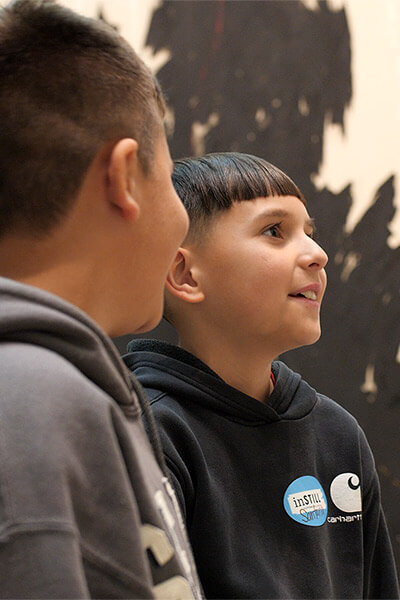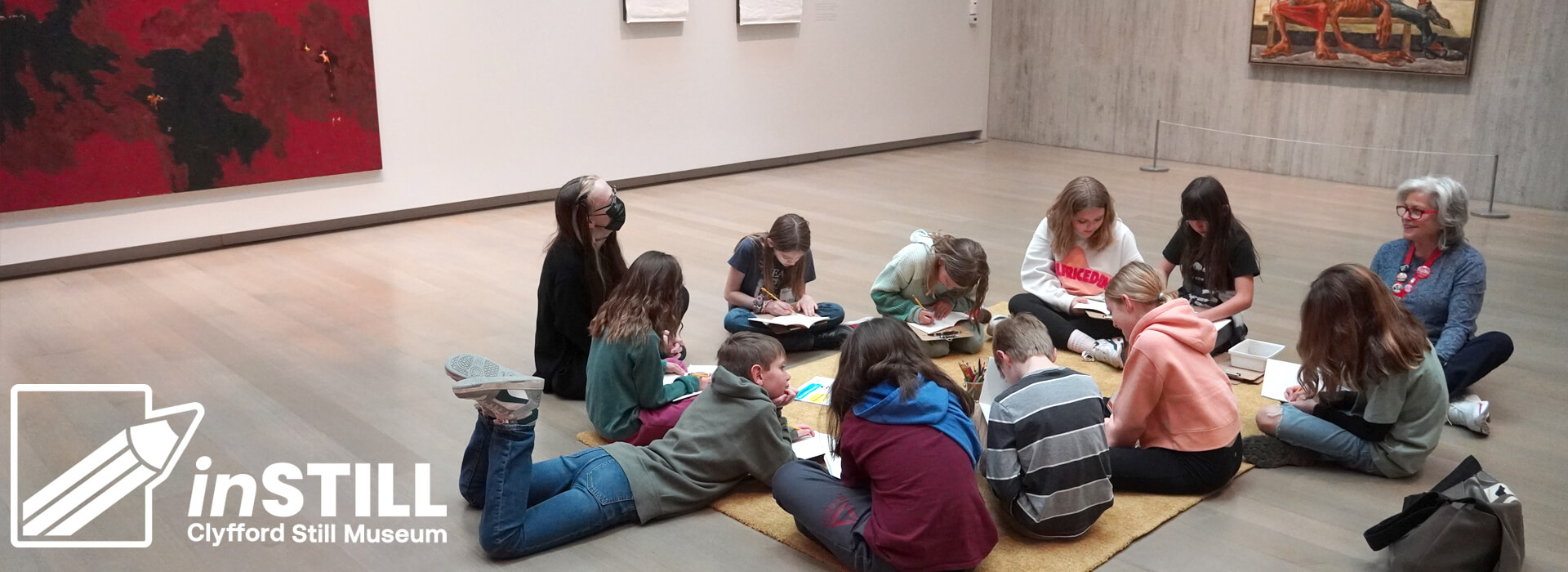Summary:
The purpose of observational drawing is to focus attention and make meaning by finding connections to visual information. In this activity, students look closely at a representational work of art and try to recreate their own version of the work. They will explore different perspectives through comparison and discussions with classmates. Students will also create personal artworks about themselves.
Big Idea:
- I can be creative. Creativity looks unique for each person.
Essential Questions:
- What are creative spaces?
- What does belonging feel like?
- How do I exist within my communities?
Learning Targets:
- I can be myself
- I can connect with my communities
- I can welcome creativity into my world
Time:
45 minutes – May be done in 2 sessions:
- Session 1 – Close Looking and artmaking (20 minutes)
- Session 2 – Second close looking, student artwork, share-out (25 minutes)
Materials:
- Paper
- Drawing Supplies
- Link to Clyfford Still Online
Standards:
Colorado Visual Arts Standards:
- Standard 1 Observe and Learn to Comprehend
- Standard 3 Invent and Discover to Create
- Standard 4 Relate and Connect to Transfer
Colorado Prepared Graduates in Visual Arts
1. See oneself as a participant in visual art and design by experiencing, viewing or making
2. Visually and/or verbally articulate how visual art and design are a means for communication
7. Allow imagination, curiosity and wonder to guide inquiry and research
National Visual Arts Standards:
- Creating Anchor Standard 2:
- Organize and develop artistic ideas and work
- Responding Anchor Standard 7:
- Perceive and analyze artistic work
- Responding Anchor Standard 8:
- Interpret intent and meaning in artistic work
CASEL SEL Framework:
- Self-Awareness: The abilities to understand one’s own emotions, thoughts, and values and how they influence behavior across contexts.
- Self-Management: The abilities to manage one’s emotions, thoughts, and behaviors effectively in different situations and to achieve goals and aspirations.
- Social Awareness: The abilities to understand the perspectives of and empathize with others, including those from diverse backgrounds, cultures, & contexts.
- Relationship Skills: The abilities to establish and maintain healthy and supportive relationships and to effectively navigate settings with diverse individuals and groups.
Steps:
1. Looking (15 minutes)
- Challenge students to look at an artwork for a brief time* (See Note) in order to make a quick reproduction of the image from memory. Encourage them to look closely and discover the subject matter and as many details as possible, as they will not be able to start their own reproduction while the artwork is visible. Let them know how much time they will have and be sure to emphasize that exact replication is not necessary for success in this project. The process of close looking, observation and making meaningful and imaginative connections is what is important. Present this as a fun challenge.
*Choose the amount of time that suits your students’ age and attention span needs. A shorter time adds a bit of urgency and fun to the task. Average recommended time is 3 minutes looking, with 7 minutes work time. - Present an image of a representational artwork (*See Note) to the students and begin the timer.
- During their looking time, side coach for those who need some guidance in looking:
- Think about what is going on in this picture
- Notice the shapes, lines and colors the artist chose
- Are there any open spaces? What is in the center? What is in the corners?
*Many museums have their artworks available virtually. The Clyfford Still Museum has nearly its entire collection online. Using the link above, you can search the collection for artworks you may want to use. Using the tools on the left side, you can sort the artwork by date, color, subject, and more. A few sample choices are listed below as well:
- PH-270 – Farm scene
- PW-7.1 – Woman hanging clothes on a line
- PH-77 – Two men in a field
- PH-451 – City buildings in Winter
You may use a physical reproduction if that works best for you. Your choice of image may also connect to other areas of your curriculum - When the looking time is over, take down or cover up the artwork. Invite students to create their version of the artwork using the available materials. Be sure to select materials with intention so that the students have what they need to do the task. Let students know how much time they have to work and remind them that they do not have to perfectly recreate everything.
2. Looking Again (10 minutes)
- Invite students to share their artwork to discover which colors and shapes were most memorable. After the comparisons, give students time to look again and discover any details that were missed.
- Take some time to discuss the artwork with students and elicit their ideas about what is going on in the image. Remind them that there are no wrong answers – the artist left it open to the viewers’ interpretations. Ask questions:
- Why do you think the artist made this artwork?
- What do you see that makes you say that?
- How do you think the artist felt about this subject? Did the artist have a connection to this? How do you know?
- What do you feel when you look at this image?Students might make inferences as to what the artist was experiencing when creating the image. Class discussion could include the choices the artist made in order to capture and communicate the subject to the viewer. Emphasize the idea that artists sometimes make art to explore things they care about, their communities or their own experiences.This conversation is a good opportunity to make SEL connections to expression of feelings, empathy, good communication and support for the ideas of others. It is also the time to connect to other curriculum areas or units of study if that is part of the focus.
3. Art Making (15 minutes)
- Invite students to use their artmaking materials to make an artwork about something or somewhere they care about. Be sure to give them some concrete examples: family, a sports team, travel plans, a pet, a beloved book or movie, or bigger issues like global warming or social justice. Share something you might choose, and (if you have time to create one), a basic model of your own artwork.
- Allow 10 minutes to make art, saving an additional 5 minutes for a share out. Side coach during the work time to reinforce your earlier conversations:
- What colors can you choose to add feelings to your artwork?
- Think about what you want the viewer to notice/wonder/be curious about.
- What story could you tell about what you are drawing?
4. Sharing (5 minutes)
- Share out: Invite students to share their art.
- Be sure to ask questions about the artwork so that students have an opportunity to tell their stories.
- Guide classmates to share positive feedback and appreciation.
- Praise students for effort, not only product. Make observations about how they looked carefully, how they added details, and how their choices impacted you, rather than comments about how the artwork looks.
Differentiation:
- Intentional choice of appropriate and relevant artwork
- Modeling, providing examples
- Conferring and supporting students during work time
- Allowing for student voice and choice in all parts of the lesson
- Making connections through focused discussion
- Mindfulness: Before students begin drawing, ask them to take a couple of silent minutes to imagine their drawing. You might invite students to write a sentence or two about the subject of their drawing and why they feel connected to the things they care about.

